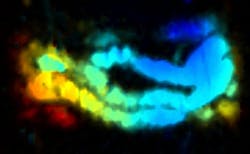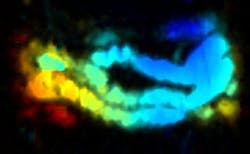Photoacoustic method shows promise for real-time, noninvasive gut exams
Recognizing that the small intestine is not easy to examine, University at Buffalo (UB; New York) researchers are developing a technique involving nanoparticles suspended in liquid to form "nanojuice" that patients would drink, followed by photoacoustic tomography (PAT) imaging to provide a noninvasive, real-time view of the organ. The advancement could help doctors better identify, understand, and treat gastrointestinal ailments such as irritable bowel syndrome, celiac disease, and Crohn's disease.
Related: Photoacoustic tomography is ready to revolutionize
X-rays, magnetic resonance imaging (MRI), and ultrasound imaging provide snapshots of the small intestine, but each suffers limitations. "Conventional imaging methods show the organ and blockages, but this method allows you to see how the small intestine operates in real time," explains corresponding author Jonathan Lovell, Ph.D., UB assistant professor of biomedical engineering.
To assess the small intestine, doctors typically require patients to drink a thick, chalky liquid called barium. Doctors then use x-rays, MRIs, and ultrasounds to assess the organ, but these techniques are limited with respect to safety, accessibility, and lack of adequate contrast, respectively. Also, none are highly effective at providing real-time imaging of movement such as peristalsis, which is the contraction of muscles that propels food through the small intestine. Dysfunction of these movements may be linked to the previously mentioned illnesses, as well as side effects of thyroid disorders, diabetes, and Parkinson's disease.
Lovell and a team of researchers worked with a family of dyes called naphthalcyanines. These small molecules absorb large portions of light in the near-infrared (NIR) spectrum, which is the ideal range for biological contrast agents. However, they are unsuitable for the human body because they don't disperse in liquid and they can be absorbed from the intestine into the blood stream.
To address these problems, the researchers formed nanoparticles called "nanonaps" that contain the colorful dye molecules and added the abilities to disperse in liquid and move safely through the intestine. In laboratory experiments performed with mice, the researchers administered the nanojuice orally. They then used PAT, which involves pulsed laser lights that generate pressure waves that, when measured, provide a real-time and more nuanced view of the small intestine.
The researchers plan to continue to refine the technique for human trials, and move into other areas of the gastrointestinal tract.
Full details of the work are described in the journal Nature Nanotechnology; for more information, please visit http://dx.doi.org/10.1038/nnano.2014.130.
-----
Don't miss Strategies in Biophotonics, a conference and exhibition dedicated to development and commercialization of bio-optics and biophotonics technologies!
Follow us on Twitter, 'like' us on Facebook, and join our group on LinkedIn
Subscribe now to BioOptics World magazine; it's free!

